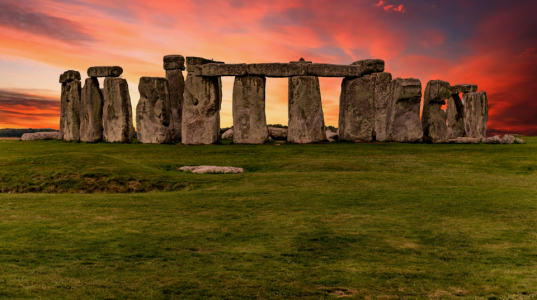You won't believe how scientists finally uncovered Stonehenge's 5,000-year-old secret!
By
Gian T
- Replies 0
Stonehenge has long stood as one of the world’s most enduring mysteries—a circle of ancient stones rising from the Salisbury Plain, captivating the imagination of everyone from curious tourists to seasoned archaeologists. For centuries, people have wondered: how did those massive stones, some weighing several tonnes, make their way to this windswept field in Wiltshire? And, more specifically, what about the smaller, enigmatic 'bluestones' that seem to have travelled an even greater distance?
Well, after 5,000 years of speculation, debate, and a fair bit of head-scratching, scientists believe they’ve finally cracked one of Stonehenge’s greatest secrets. And the answer is as fascinating as the monument itself!
The Bluestone Conundrum
Let’s set the scene: Stonehenge isn’t just made up of one type of stone. The iconic, towering sarsens (the big ones) were sourced relatively locally, from West Woods in Wiltshire, about 32km away. But the smaller bluestones—about 80 of them—are a different story. These rocks, some weighing up to 3.5 tonnes, have been traced all the way back to the Preseli Hills in Wales, over 200km from Stonehenge. That’s a long way to drag a rock, especially without the benefit of modern machinery!
For years, experts have debated how these stones made the journey. Was it the work of determined Neolithic people, hauling them over land and water? Or did glaciers do the heavy lifting during the last Ice Age, carrying the stones south and depositing them near Salisbury Plain?
A Boulder Breakthrough
Enter the Newall boulder—a football-sized chunk of rock unearthed at Stonehenge about a century ago. This humble stone has become the star of the latest research, led by Professor Richard Bevins from Aberystwyth University. By comparing the Newall boulder to rocks from a specific outcrop in Wales (Craig Rhos-y-Felin, for those keeping score), the team used geochemical and microscopic analysis to look for a match.
The verdict? The Newall boulder is a dead ringer for the rocks at Craig Rhos-y-Felin. Not only do they share identical levels of thorium and zirconium, but the boulder’s surface also shows signs of long burial in the chalky soils of Stonehenge—something you wouldn’t expect if it had been dropped by a glacier. If glaciers had been responsible, we’d expect to find similar stones scattered all over the region, not just at Stonehenge.
Human Ingenuity on Display
So, what does this mean? The evidence overwhelmingly points to human hands (and backs, and probably a lot of rope and wooden sledges) being responsible for moving these stones. The researchers argue that if Neolithic people could move the massive sarsens a few dozen kilometres, they could certainly manage the bluestones over a longer distance—especially since moving a 3.5-tonne stone is a lot easier than shifting a 20-tonne one!
And it’s not just the Newall boulder. Another stone at Stonehenge, previously thought to be a different type of rock, has now been identified as the same kind of foliated rhyolite as the Newall boulder, further strengthening the case for human transport.
A Monumental Effort
Just imagine the logistics: Neolithic builders quarrying stones in the wilds of Wales, then hauling them over hills, across rivers, and possibly even floating them along the coast before dragging them the final stretch to Salisbury Plain. It’s a feat that would have required not just muscle, but also planning, cooperation, and a shared sense of purpose.
Why go to all this trouble? That’s a question that still puzzles archaeologists. Some suggest Stonehenge was a place of religious or political significance—a site to unite different tribes, honour ancestors, or mark astronomical events. Whatever the reason, the effort involved in building Stonehenge speaks to the determination and ingenuity of our ancestors.
The Altar Stone and Other Mysteries
And if you thought 200km was a long way to move a stone, get this: recent research suggests the famous 'Altar Stone' at the centre of Stonehenge may have come from as far away as northern Scotland—up to 1,000km away! That’s a journey that boggles the mind, even
What About the Glacier Theory?
Of course, not everyone agrees. Some geologists, like Dr Brian John, have argued that glacial action could explain the presence of the bluestones. But the latest research finds little evidence to support this. The specific chemical signatures, the lack of similar stones elsewhere, and the context of the finds all point to human agency.
As the researchers put it: 'The presence of Stonehenge itself is the evidence of movement by Neolithic peoples of stones weighing up to as much as 40 tonnes. If Neolithic people could move a stone a few tens of metres, they could move it tens or hundreds of kilometres.'
A Testament to Human Achievement
Stonehenge remains exceptional among ancient monuments for being constructed entirely of stones brought from far and wide, rather than using whatever was lying around nearby. It’s a testament to the vision, organisation, and sheer determination of the people who built it.
While we may never know exactly why Stonehenge was built, or the full story of how each stone made its journey, this new research brings us closer than ever to understanding one of history’s greatest engineering feats.
 Have you ever visited Stonehenge, or do you have your own theories about how it was built? Do you marvel at the ingenuity of our ancestors, or do you think there’s still a mystery waiting to be solved? We’d love to hear your thoughts and stories—share them in the comments below!
Have you ever visited Stonehenge, or do you have your own theories about how it was built? Do you marvel at the ingenuity of our ancestors, or do you think there’s still a mystery waiting to be solved? We’d love to hear your thoughts and stories—share them in the comments below!
Read more: Kept under the stairs for decades—turns out this old bowl was worth $7,700!
Well, after 5,000 years of speculation, debate, and a fair bit of head-scratching, scientists believe they’ve finally cracked one of Stonehenge’s greatest secrets. And the answer is as fascinating as the monument itself!
The Bluestone Conundrum
Let’s set the scene: Stonehenge isn’t just made up of one type of stone. The iconic, towering sarsens (the big ones) were sourced relatively locally, from West Woods in Wiltshire, about 32km away. But the smaller bluestones—about 80 of them—are a different story. These rocks, some weighing up to 3.5 tonnes, have been traced all the way back to the Preseli Hills in Wales, over 200km from Stonehenge. That’s a long way to drag a rock, especially without the benefit of modern machinery!
For years, experts have debated how these stones made the journey. Was it the work of determined Neolithic people, hauling them over land and water? Or did glaciers do the heavy lifting during the last Ice Age, carrying the stones south and depositing them near Salisbury Plain?
A Boulder Breakthrough
Enter the Newall boulder—a football-sized chunk of rock unearthed at Stonehenge about a century ago. This humble stone has become the star of the latest research, led by Professor Richard Bevins from Aberystwyth University. By comparing the Newall boulder to rocks from a specific outcrop in Wales (Craig Rhos-y-Felin, for those keeping score), the team used geochemical and microscopic analysis to look for a match.
The verdict? The Newall boulder is a dead ringer for the rocks at Craig Rhos-y-Felin. Not only do they share identical levels of thorium and zirconium, but the boulder’s surface also shows signs of long burial in the chalky soils of Stonehenge—something you wouldn’t expect if it had been dropped by a glacier. If glaciers had been responsible, we’d expect to find similar stones scattered all over the region, not just at Stonehenge.
Human Ingenuity on Display
So, what does this mean? The evidence overwhelmingly points to human hands (and backs, and probably a lot of rope and wooden sledges) being responsible for moving these stones. The researchers argue that if Neolithic people could move the massive sarsens a few dozen kilometres, they could certainly manage the bluestones over a longer distance—especially since moving a 3.5-tonne stone is a lot easier than shifting a 20-tonne one!
And it’s not just the Newall boulder. Another stone at Stonehenge, previously thought to be a different type of rock, has now been identified as the same kind of foliated rhyolite as the Newall boulder, further strengthening the case for human transport.
A Monumental Effort
Just imagine the logistics: Neolithic builders quarrying stones in the wilds of Wales, then hauling them over hills, across rivers, and possibly even floating them along the coast before dragging them the final stretch to Salisbury Plain. It’s a feat that would have required not just muscle, but also planning, cooperation, and a shared sense of purpose.
Why go to all this trouble? That’s a question that still puzzles archaeologists. Some suggest Stonehenge was a place of religious or political significance—a site to unite different tribes, honour ancestors, or mark astronomical events. Whatever the reason, the effort involved in building Stonehenge speaks to the determination and ingenuity of our ancestors.
The Altar Stone and Other Mysteries
And if you thought 200km was a long way to move a stone, get this: recent research suggests the famous 'Altar Stone' at the centre of Stonehenge may have come from as far away as northern Scotland—up to 1,000km away! That’s a journey that boggles the mind, even
What About the Glacier Theory?
Of course, not everyone agrees. Some geologists, like Dr Brian John, have argued that glacial action could explain the presence of the bluestones. But the latest research finds little evidence to support this. The specific chemical signatures, the lack of similar stones elsewhere, and the context of the finds all point to human agency.
As the researchers put it: 'The presence of Stonehenge itself is the evidence of movement by Neolithic peoples of stones weighing up to as much as 40 tonnes. If Neolithic people could move a stone a few tens of metres, they could move it tens or hundreds of kilometres.'
A Testament to Human Achievement
Stonehenge remains exceptional among ancient monuments for being constructed entirely of stones brought from far and wide, rather than using whatever was lying around nearby. It’s a testament to the vision, organisation, and sheer determination of the people who built it.
While we may never know exactly why Stonehenge was built, or the full story of how each stone made its journey, this new research brings us closer than ever to understanding one of history’s greatest engineering feats.
Key Takeaways
- New scientific analysis strongly supports the theory that Stonehenge’s famous bluestones, including the Newall boulder, were transported over 200km from Wales to Wiltshire by Neolithic people, not by glacial action.
- Geochemical and microscopic evidence matches the Stonehenge bluestones precisely with the rocks from Craig Rhos–y–Felin in north Pembrokeshire, ruling out the glacial erratic theory.
- The study confirms that the effort to bring massive stones—some weighing over three tonnes—to Stonehenge demonstrates extraordinary logistical capability by ancient builders and distinguishes Stonehenge from other stone circles, which typically used more local materials.
- While the origins of the stones are now clearer, why and exactly how Stonehenge was built remains a mystery, with researchers suggesting it may have held both religious and political significance for unifying ancient Britons.
Read more: Kept under the stairs for decades—turns out this old bowl was worth $7,700!








